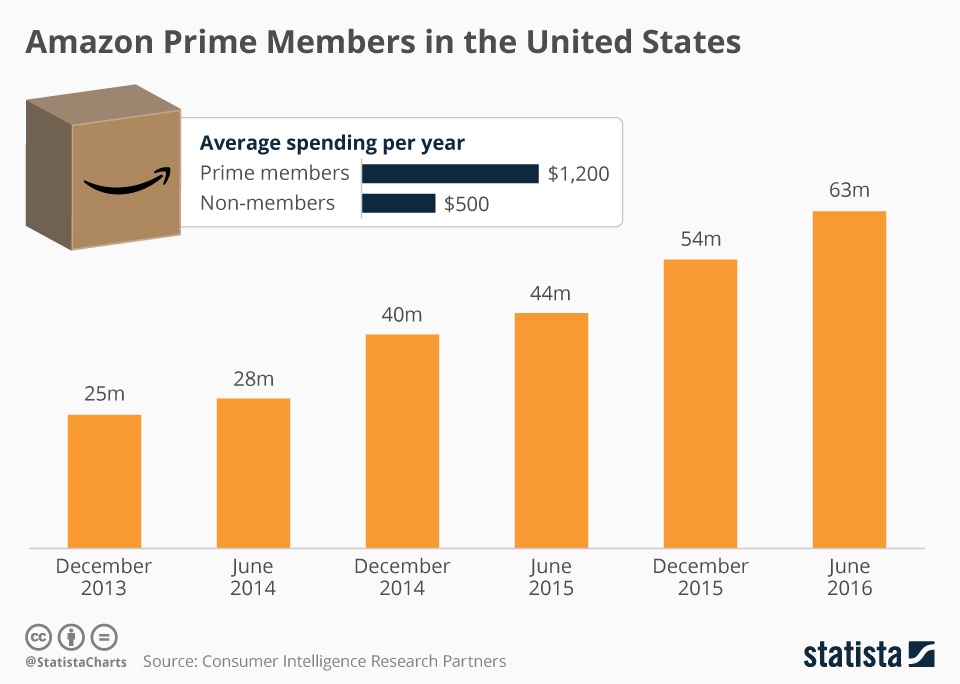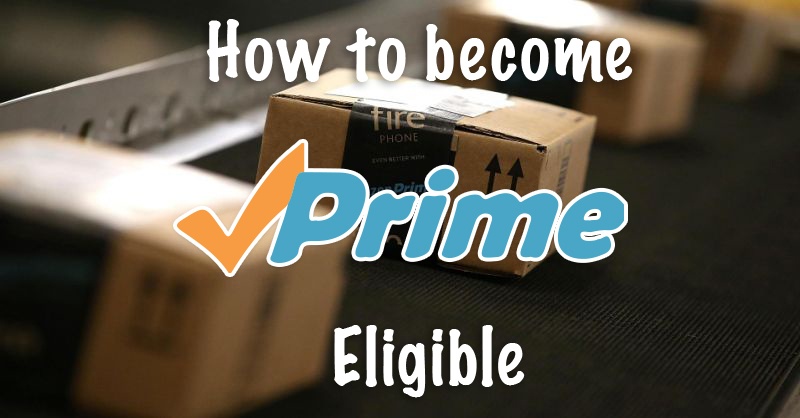It’s no secret that Prime is a brand that’s taken very seriously by Amazon, shoppers, and merchants like yourself. And rightly so – Prime is huge
For online retailers this is important because Prime members are big shoppers all year round. Amazon’s 50 million Prime members spend around $1,200 per year on average, compared to about $500 per year for non-members (as represented in the chart above).

Events like Prime Day just reinforce this. Unless you’ve avoided all industry news over the last two years you will know that Prime Day is now the biggest shopping day in the world – bigger even than Black Friday.
And this year’s Prime Day – which takes place annually on 12 July – smashed last year’s astounding records, selling more than 60% worldwide and more than 50% in the US. It was declared, ‘the biggest day in the history of Amazon’ by the Vice President of Amazon Prime, Greg Greeley. And he should know. You can read the full details here.
To give you an idea of how that translates to inventory, Prime Day 2016 included the sale of more than 90,000 televisions, 200,000 headphones, and 215,000 pressure cookers – and that’s barely scraping the surface of what was actually sold that day!
So you know Prime is essential. And you’ll soon know how YOU can get a piece of the action.
There are two programs that grant you Prime access: Fulfilled by Amazon or Seller Fulfilled Prime. Both have their pros and cons, and will appeal to different businesses of different sizes.
Want to be a highly educated Amazon seller?
Download the definitive guide to Amazon's Seller Fulfilled Prime program for free today.
Get your free Amazon book
Making sense of Fulfillment by Amazon (FBA)
Launched in September 2006, FBA is your first stop to getting that Prime badge. For businesses of any size, it’s a way to lay your products out on those golden Amazon Prime shelves in front of millions of Prime Members, without having to have a fulfillment service as big or experienced as Amazon’s.
That’s because Amazon do everything for you. You just send a portion of your inventory to Amazon’s fulfillment centers, where it’s securely stored until customers make the purchase. Amazon will then pick, pack and ship the items to your customers for you, as well as provide top-class customer service and handle returns on your behalf.
Sounds too good to be true doesn’t it? Let’s look at the advantages and disadvantages of this program:
FBA Advantages
Huge Market
The obvious one – using the FBA service allows you to get your products Prime-eligible, giving you huge exposure and opening your business to that massive market of around 50 million Prime customers.
Save Time
Without having to focus on the time, energy and money-consuming pick, pack and shipping process, you can use your time and resources more efficiently to grow and strengthen your business.
Save Storage Space
Don’t have access to a huge warehouse for your inventory? With FBA it’s not necessary as Amazon store it all for you for a fee.
Save On Resources
With FBA you don’t need a large customer service department, as Amazon do it on your behalf. Same goes for a returns department, as Amazon handle that too.
FBA Disadvantages
Big Fees
Here’s the elephant in the room! You can’t expect Amazon to do everything for you for free. And the FBA Fulfillment fees can quickly add up. For example: a $1.00 Order Handling fee, $1.06 Pick and Pack fee, $0.50+ Weight Handling fee, $0.54+ Storage fee… all for one non-media item. While the prices change depending on what it is you are selling, these fees start to add up.
Less Inventory Control
With Amazon in charge of the pick, pack and shipping process, you don’t get to pop down to the warehouse to see exactly what you have. With FBA it’s tricky to determine exactly what remains in stock, and this could lead to stale inventory – and there are big penalty fees for inventory stored in a Fulfillment Center for longer than six months. Which isn’t good news for slow moving items either.
Not Always Profitable
Not every product you sell with FBA will be profitable, so you’ll have spend time determining which to send to Amazon and which to keep for yourself. For example, products that have low margins just don’t make sense to sell via FBA, especially if they are big and heavy (remember storage and weight fees). Selling some things on FBA could severely eat into your profit.
Making sense of Seller Fulfilled Prime (SFP)
If FBA has stirred your interest, Seller Fulfilled Prime will certainly make you sit up. SFP is a newer approach to selling on Amazon and was introduced in May 2015. Like FBA, it permits you to display the all important Prime badge on your items, giving you access to that huge Prime market, but gives you much more freedom with inventory control, shipping and returns.
This is because, unlike FBA, you ship directly to your customers from your warehouse, meaning you can source and negotiate the most cost-effective shipping solutions, while avoiding the high fees associated with FBA. It was for those businesses that originally had to use FBA because it was the only way to get into the Prime market, but didn’t really need to use Amazon’s fulfillment.
SFP Advantages
The benefits of Seller Fulfilled Prime are clear:
Huge Market
I don’t want to repeat myself, but SFP shares this one with FBA – if your products are Prime-eligible, you have access to that huge market of around 50 million big-spending, loyal Prime customers.
Avoid Amazon Fees
As you are not sending anything to Amazon to be stored, handled, packed or returned, there is no need for them to invoice you with eye-watering fees. Your profit is yours.
Full Inventory Control
You’re unlikely to exclusively sell your product on Amazon, and trying to juggle inventory split between both your own and Amazon’s warehouses (like you’d do with FBA) can be a headache. With SFP you keep all your inventory in one central location and therefore have complete control of your stock. This is certainly a benefit when it comes to those big shopping times, like Prime Day or Black Friday, as there’s no limit on how much you can sell.
Returns Control
Unlike FBA – which sees Amazon handle returns and send members a general box of returned goods – SFP sees your company handles all returns. As things are less vague, you can easily identify exactly which returned item ties to which order, meaning you are much less susceptible to customer fraud (which happens often!).
SFP Disadvantages
Need Storage Space
There’s no getting around this one – if you fulfill hundreds of products daily and aren’t using Amazon’s storage space, you’ll certainly need your own warehouse and warehouse staff, which can be costly to both acquire and maintain.
Instant Refunds
With SFP you have just two business days from the moment a returned item reaches you to issue a refund. Compare this to the five days you have with a non-Prime order.
Strict Requirements
Amazon are incredibly protective over Prime, so if you’re going to be providing Prime service without going through Amazon’s warehouse you can guarantee your every move will be scrutinized. You’ll need to follow a list of strict requirements, and survive a trial period to demonstrate that you can meet their rules on customer satisfaction on a minimum of 300 orders.
We’ll be discussing these in more detail, and how RetailOps can help, in the next article, but briefly the seller fulfilled prime requirements you’ll have to satisfy are:
- An On-Time Shipment Rate of at least 99% for Prime trial orders
- Use of Buy Shipping Services for at least 95% of Prime trial orders
- A Cancellation Rate of less than 1% on Prime trial orders
The Main Event: FBA vs. SFP
Amazon Prime members compared to non-membersIf your products are not on Prime then you need to be part of one of these programs. Which one you settle on will primarily depend on the size and aspirations of your business. And – because every business is different – it’s reassuring that there is a choice, instead of a ‘one Prime fits all’ policy.
Fulfillment by Amazon, for example, is perfect for small and medium-sized businesses, and newer companies who aren’t fully established in their marketplace. You aren’t likely to have access to your own warehouse or a big customer service department, and won’t care too much about handling returns yourself. Store, pick, pack and ship, Amazon will do everything for you, giving you ample time to grow your business in the right direction.
Of course you must factor in the fees, because these will certainly eat into your profits. You are also limited with inventory control and perhaps more open to fraudulent returns, but for the smaller business FBA is a great way to venture into that epic market.
However, if you’re the owner of an established company shipping around 500+ orders a day, you will – or should – already have your own well-run warehouse and a solid customer service department. You can handle a large flow of inventory and know that Amazon’s requirements are tough but achievable (especially with the help of tailored WMS such as RetailOps).
This is when Seller Fulfilled Prime is your best route. With the warehouse and your own team, there’s no need to fork out the high Amazon fulfillment fees, so you can still benefit from being Prime-eligible and maximize your profit at the same time.
Of course, you’ll be under constant scrutiny from Amazon, but for more control over your own inventory and returns, it’s worth it. SFP gives you more freedom to grow your business the way you want.
Want more details? Get our 50-page Amazon eBook.
Get the complete Amazon guide in your inbox
Download the definitive guide to Amazon's Seller Fulfilled Prime program for free today.
Get your free Amazon book